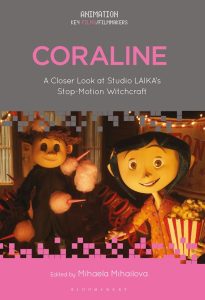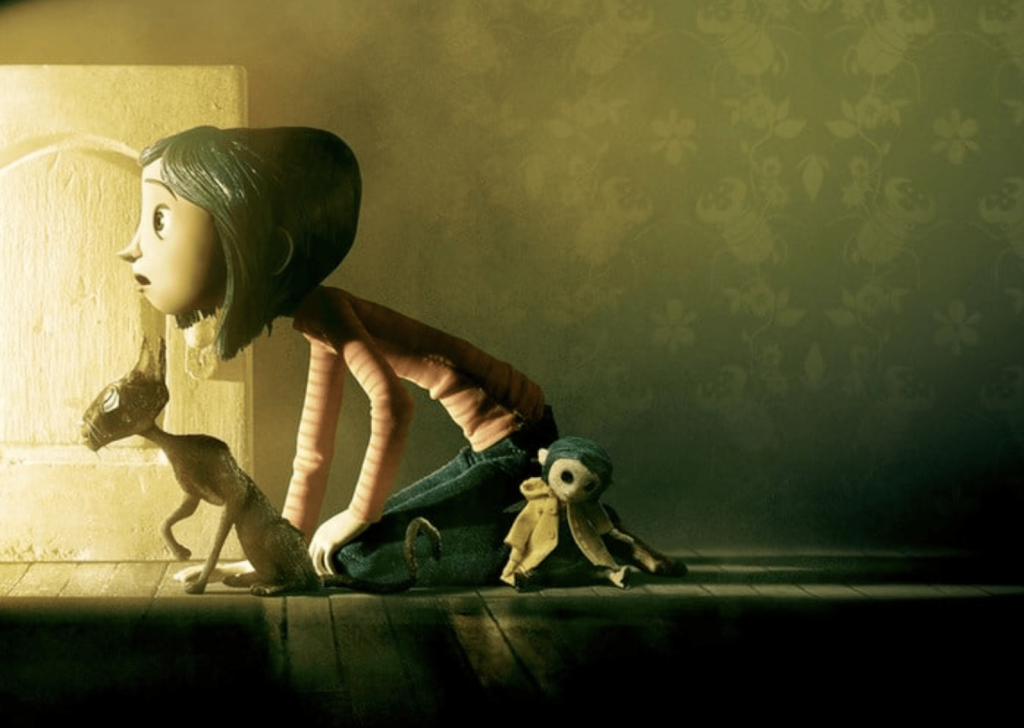In the introduction of the recently published anthology Coraline: A Closer Look at Studio LAIKA’s Stop-Motion Witchcraft, editor Mihaela Mihailova writes, “Like witchcraft, puppet craft remains poorly understood and frequently branded as a relic of a bygone era — and yet, it has endured, an art form equal parts mystifying and awe-inspiring. The goal of the following pages is to dispel some of that mystery, while preserving all of the wonder” (Mihailova 14). Striking a balance between rigorous analysis while sustaining the sense of awe that the film inspires is an ambitious undertaking. Mihailova and her contributors have achieved this enlightening equilibrium in the chapters of this book.
As Norman A. Klein writes in Chapter 4, Coraline is about being trapped between two worlds. The concept of occupying a space between opposing forces is the common thread that appears throughout the chapters of Mihailova’s anthology, each time from a different perspective. It is clear that there is a consensus amongst the contributors that a compelling power arises from the tension between seemingly opposite elements; stop-motion and 3D printing, agency and submission, horror and delight. What is most rewarding about reading the collection is how many different access points the contributors have used to observe that power. With a fourteen page introduction and twelve different contributors, it would be understandable if there was at least a little bit of overlap between the writers’ perspectives and arguments. In the pages of this collection, however, the reader will not find any repetition or redundancy.
The book is organized into three sections. The chapters do not necessarily need to be read in chronological order, yet this organizational structure provides a useful roadmap for its readers. The first section, titled Historical Contexts and Perspectives, explores where Coraline could be placed in the context of animation history. In Chapter 1, Malcolm Cook illuminates the role of drawing in all stages of the film’s creation, from the influence of Victorian illustration on Neil Gaiman’s novel to the aesthetic conventions of LAIKA’s hand fabricated sets. Additionally, Cook pays homage to several important contributors to the pre-production phase of the film; artists who are often overlooked beyond a small mention in the end credits. Another notable feature of this section involves references to Jan Švankmajer’s work by both Miriam Harris and editor Mihaela Mihailova, and how Coraline’s resistance to conformity mirrors the motivations of earlier Eastern European animators. The section concludes with a chapter by Norman Klein that includes masterfully crafted descriptions of Coraline’s parents, such as “[Charlie Jones’] head could slide forward at the neck, like a cash register… that allowed him to look endlessly unprepared for what is going on” (Klein 80). This chapter alone is reason enough to read the book. The connections that Klein makes between the film and the impact of the contemporary gig economy on families are brilliantly revelatory.
Part Two, titled Stop-Motion Technology, Process, and Spectatorship, examines the juxtaposition between analog and 3D techniques in the film. In Chapter 5, which is about the revolutionary use of 3D printing with replacement animation, Dan Torre writes that “replacement animation also becomes a kind of meta narrative that permeates the film” (Torre 97). Other contributors to this section address the ways in which different features of the technology used by LAIKA became tangible visible elements of the narrative, described eloquently by Jane Shadbolt as “a kind of compulsion to share the incredible nature of the process of filming through the film itself” (Shadbolt 129). In a fascinating study of the neuroscientific theory of Simulation, Ann Owen argues that the use of highly tactile materials enables viewers of Coraline to feel empathy and transference for the experiences of the characters in a visceral way that would not be possible without the use of stop-motion techniques, and Rayna Denison examines how the controversy of the PG rating of the film can be used as an exploration of the tension between what she describes as “darkness and delight” (Denison 153). The tenet that unifies the chapters in this section is an acute awareness of the ways in which the presence of the process in the film influences the experience of the film’s audience. The arguments posed in these chapters explain how the on-set risks taken by the film’s creators resulted in a transcendent cinematic experience for the viewer.
The last section of the collection, titled Puppet Politics: Ideology, Identity, Representation, focuses on Coraline herself. As Jane Batkin writes in Chapter 11, the authors who contributed to these last chapters explore what family means through issues of identity, belonging, and the othering of characters. Notable arguments from this section include Batkin’s description of Coraline as a “wandering child” (Batkin 209), and Kodi Maier’s establishment of a queer reading of the film. More specifically, Maier elaborates that “the film’s use of magic and witchcraft opens Coraline up to being both a source of inspiration for and an allegory of queer resistance” (Maier 172). In Chapter 10, Eric Herhuth writes about parallels between puppethood and childhood; specifically how “the puppet’s lack of autonomy and awareness and its otherness are admired in a romantic fashion comparable to idealized fantasies about childhood” (Herhuth 193). The section concludes with a chapter by Nicholas Andrew Miller about the presence of Neil Gaiman himself as the ‘Author Father’ in addition to Charlie Jones; and their potential to shape “for good or ill, a daughter’s experience of her own bravery” (Miller 227). The decision to end the book with Miller’s chapter is one of the ways in which this book fulfills Milhanova’s promise to ‘dispel mystery while preserving wonder’. Although Coraline compels us to make connections with neuroscience, Freudian theory, and the role of technology in historical processes, at it’s core it’s a film about how a family learns to care for each other in the midst of extreme adversity.
To summarize, Mihailova and her contributors have compiled the most comprehensive and complete academic analysis of Coraline to date. Previously, we have seen limited overviews of Coraline’s thematic elements, such as Anna Colclasure’s Coraline Unpacked: Thematic Analysis and Imagery Interpretation of the Dark Fantasy, Stop-Motion Film and Stephen Jones’ Coraline: A Visual Companion, but these earlier books do not place the film in the context of animation history and are instead meant to increase the fan base of the film rather than critically assess its cultural significance. However, Coraline: A Closer Look at Studio LAIKA’s Stop- Motion Witchcraft fulfills a previously unmet need to examine the many layers of meaning in Coraline through a critical lens, while reminding the reader why the film is worthy of such a comprehensive examination. Although the animated film Coraline was released in 2009, the arguments posed in Mihailova’s anthology are expansive beyond the early 21st century, and will be culturally relevant resources for scholars for many years to come.
Kate Renner is an Assistant Professor of Visual Art at Vermont State University – Lyndon, where she teaches courses in Drawing, Animation, and 3D Modeling. She is also the Director of the Vermont Animation Festival.


